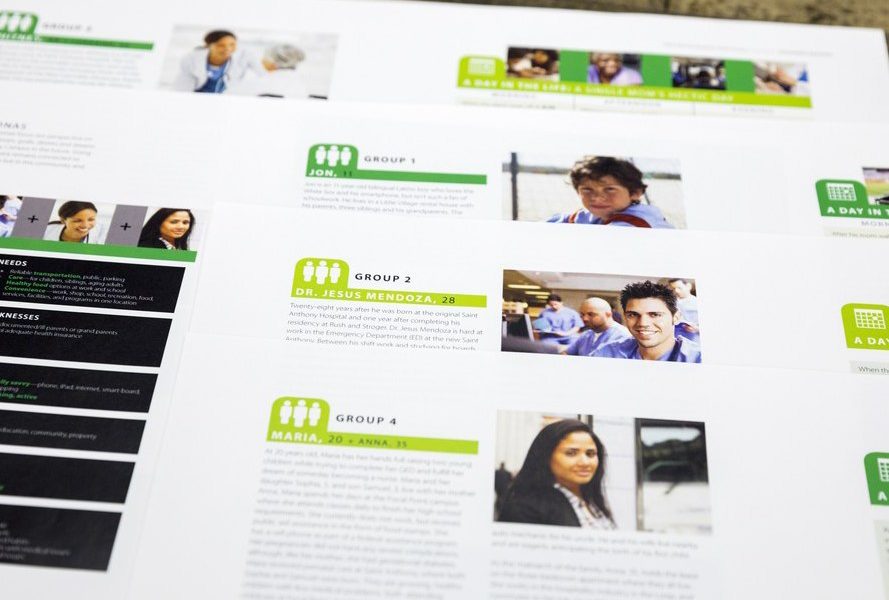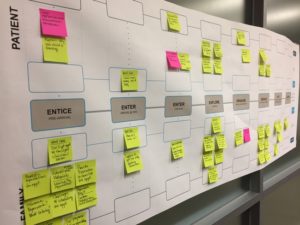 Personas used to design for the human experience. Photo courtesy of Dan Schwalm, HDR.
Personas used to design for the human experience. Photo courtesy of Dan Schwalm, HDR. Subscribe Now
How Human Experience Informs Design
Who will use this space?
Too often, architects design buildings without looking the building users in the eyes, and without understanding who the users really are. What type of family do they come from? What is their ethnicity or cultural background? What are their likes, dislikes, fears and values? We often design for the average or the generic, such as “the children” or “the patients” or “the clinicians.” If that’s not enough, we try to be more specific: “behavioral health patients” or “patients with autism.” Even then, we often fall short. Instead of designing a treatment space for a young patient with autism, let’s design a treatment room for Alex. Instead of designing a waiting area for a patient suffering from depression, let’s design a waiting area for Derrick. Let’s design for real people.
Before HDR architects recently put pencil to paper to design a new behavioral health clinic for a children’s hospital, the team intimately got to know five patients: Chase, Alex, Gabriella, Lillian and Derrick:
- Chase is a 5-year-old who exhibits disruptive behavior at school. He likes baseball and playing outside.
- Alex is a non-verbal second grader with autism who loves spending time with his puppy.
- Gabriella is a 12-year old who has been in and out of foster care most of her life and, from time to time, still hears her mother’s voice.
- Lillian has become very self-conscious about her weight since starting high school. She values her parents and fears acceptance.
- Derrick has struggled with depression for most of his teenage years and, although he is on the upswing, college has been tough for him.
These five patients have likes, dislikes, needs, wants, fears, values and beliefs. While these five kids feel very real — even to us — you may be surprised to hear that the team created them to instill empathy into the design process. They’re called personas.
Inventing reality
Chase, Alex, Gabriella, Lillian and Derrick are personas invented at the onset of the design process for the new clinic to better understand the patient population for which we were designing. We were no longer designing for “mental health patients” or “children with autism.” We were designing for Chase. We were designing for Alex. We were designing for Gabriella, and Lillian, and Derrick. Each one of them has unique needs and preferences that must be accounted for in the new space. Without this process, specific, personal-experience elements or attributes would almost certainly be overlooked in the design and operations of the new clinic.
To ensure these personas possessed inherently real qualities, we began the human-experience design process through a rigorous exercise of persona development. We collected and analyzed demographic data, researched medical symptoms and identified personal preferences associated with various mental and behavioral health conditions. We also consulted providers and family members to help develop the personas to secure the accuracy and appropriateness of their qualities — from likes and dislikes, to diagnoses and treatment plans.
Once the personas were created, we developed scenarios that began to tell the story of each persona’s visit to the new clinic. The scenarios were the starting point for a human-experience workshop: an ongoing process in which we invited providers, staff and family members to map each persona’s journey by focusing on various touch points throughout their visits. Workshop participants identified the best case and worst case for each persona and their family at each touch point, including the potential obstacles and opportunities that could prevent or enable the patients and family to achieve the best outcomes.
Insights revealed
From the findings uncovered during the patient-mapping exercise, we extrapolated insights that include commonalities and anomalies to be addressed in the design of the new clinic to improve the patient and family experience.
With this specific project, those insights were categorized into eight themes:
- Privacy and dignity
- Communication
- Navigation and flow
- Remote check-in
- Waiting vs. sub-waiting
- Amenities and resources
- Optimize check-out process
- Extending care beyond the clinic
Diving further into each of these themes, we begin to address physical elements of the new space such as color and texture of building materials, light intensity and color and noise levels emitted from HVAC equipment, as well as operational efficiencies such as enabling app-based check-in processes, providing adequate information prior to appointments and offering post-visit follow-up communication. Because of the wide range of strategies uncovered throughout the human-experience process, other teams such as facilities managers and their staff can follow a similar exercise to improve their current facility without necessarily requiring major renovations. When implemented strategically, the insights obtained through the human-experience process will provide an opportunity to create an ideal experience for each persona and ultimately the entire patient population of the new clinic.
Chase’s mom will be able to check out with ease, Alex will have a quiet place to wait for his appointment, Gabriella will be greeted with warmth, Lillian will arrive to her appointment stress free and Derrick will feel like he belongs.
The five personas may be fictitious characters built on imagination, data and personal insight, but project team members still find themselves referring to them as if they’re real people. They have become intimately connected with them. “How would Chase perceive this space?” “Would Lillian feel comfortable here?” “Where can Derrick find a quiet place to wait away from the younger kids?”
The design of the new clinic can impact the experiences of clients and the patient community, and this is just one way to build empathy for both into the process. The connection developed with the personas and the insights gleaned through the human-experience process gives confidence that, when the real Chase, Alex, Gabriella, Lillian and Derrick visit the clinic, the project team has asked the right questions, and they’ll receive world-class care in a space uniquely designed as their own.
Tags: Architecture, human experience
Posted January 16, 2018
More Articles:
- State of Industry Examined in ‘Healthcare Reset’ Report
- Cam Twohey Joins Kahler Slater as Associate Principal, Senior Project Architect in Healthcare Market
- Perkins Eastman Welcomes Michael Hess as Principal in New York Studio
- Guerin Children’s Inpatient Pediatric Unit at Cedars-Sinai Provides Interactive, Family Friendly Healing Environment
- Coverings 2024
Apr 22, 2024 – Apr 25, 2024 - Hospital, Outpatient Facilities & Medical Office Buildings Summit
Apr 25, 2024 – Apr 25, 2024 - CxA Workshop & Exam
Apr 29, 2024 – Apr 30, 2024 - EMP Seminar & Exam at CxEnergy 2024
Apr 29, 2024 – Apr 30, 2024 - CxEnergy
Apr 29, 2024 – May 2, 2024 - PHCC West 2024
Apr 29, 2024 – May 2, 2024 - Lean in Design Forum 2024
May 1, 2024 – May 2, 2024











